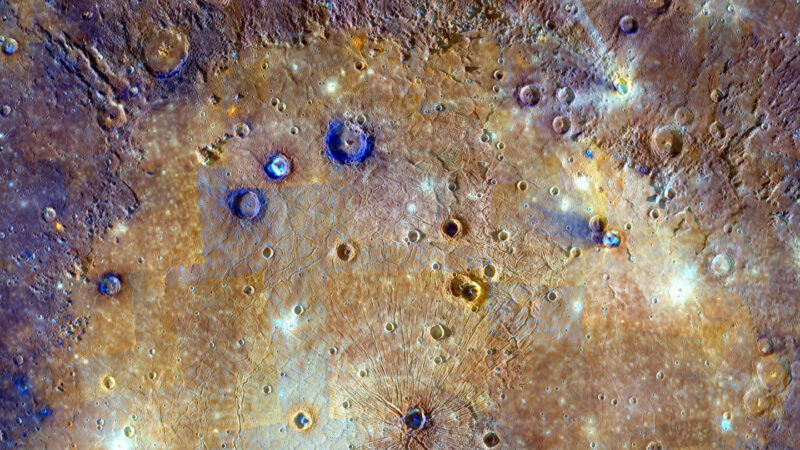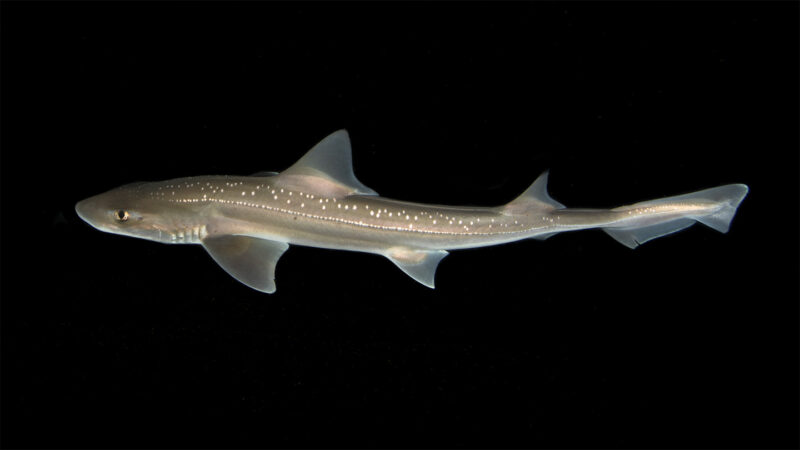Craters are round, bowl-shaped depressions surrounded by a ring, like the one shown in Figure 1. They are made when a meteorite collides with a planet or a moon. Craters are what make our moon look like Swiss cheese. Each round hole is the place where a meteorite impacted, or hit, the surface of the moon, so craters are often called impact craters. Often, the meteorite that creates a crater explodes on impact, so the crater is an empty reminder of the collision.
There are meteoroids traveling around throughout space, and all of the moons and planets in our solar system have been impacted by meteorites since its formation. (Note: they are called meteoroids when they’re still in space, and meteorites when they land on a planet or moon.)
On Earth, we only see a few impact craters, for a couple of different reasons. First, most meteoroids never reach the Earth’s surface because they burn up in the atmosphere. This is what we are seeing when we watch a shooting star during a meteor shower (meteor refers to the visible streak of light). Second, impact craters from meteorites can be changed by geological forces (like earthquakes and continental movements) or eroded away by atmospheric forces (like wind or rain). There is no atmosphere on the moon, which means that falling meteoroids do not burn up and there is no weather to erode away the craters. In fact, the footprints of the astronauts who landed on the moon over 50 years ago are still there!
Where can you find impact craters on Earth? There are only about 170 confirmed impact craters on Earth. Not all of them are obvious because most are eroded, covered by sediment or under water. Each crater has to be identified using several different kinds of clues. First, geological clues are found by looking for pieces of the exploded, iron-rich meteorite or for glass that formed during the impact. Satellite imaging can be used to visualize crater formations that are beneath the Earth’s surface or a body of water. Finally, chemical evidence is used to date the crater and find traces of elements that are more common in space than on our planet.
By piecing together this evidence, scientists can study craters on Earth and link them to different periods of Earth’s history. This involves many different types of scientists, including astronomers, geologists, chemists, paleontologists and meteorologists (who actually study weather, not meteorites). This has led to an interesting hypothesis being proposed about the formation of a sea, the extinction of the dinosaurs and even the origins of life!
In this science project, you will investigate whether the size of a crater depends upon the size of the meteorite. To test this, you will use different-sized, nearly spherical objects as your “meteorites,” like the objects shown in Figure 2. What types of clues will you look for in your investigation? How will studying an impact crater give you information about the collision, even if the meteorite is no longer there? Are there other clues of a meteorite impact that are important?
In this experiment, we make our own craters in cocoa and flour to investigate how these features form on planets and moons.
Terms and concepts
Crater
Meteorite
Meteoroid
Meteor
Planet
Moon
Impact crater
Diameter
Questions
How do you think the size of a crater is related to the size of the meteorite?
What is the difference between a meteor and a meteorite?
What is a shooting star?
How is an impact crater formed?
Materials and equipment
Different-sized objects that are nearly spherical (at least three total), such a rubber ball, a baseball and a piece of round fruit.
Tip: Solid objects may work better than hollow ones.
Note: Smaller objects, such as marbles and beads, will not work well for this science project unless you use metal or magnetic balls and a magnet to carefully remove them.
Ruler (metric)
Cardboard box that is larger than a shoebox and fairly deep. Something like a small moving box would be perfect.
Flour (4.5-kilogram, or 10-pound, bag)
Cocoa powder
Flour sifter or sieve
Optional: Graph paper
Lab notebook
Experimental procedure
1. In your lab notebook, make a data table like Table 1. Be sure to include the types of objects that you will be testing.
2. Using a ruler, measure the diameter of each of your nearly spherical objects (in centimeters). The diameter is the distance across the middle of the sphere, from one side to the other. Write your measurements in the data table in your lab notebook. Each object will serve as a “meteorite” in this science project.
ObjectDiameter of object (cm)Diameter of craters (cm)Average crater diameter (cm)Rubber ballBaseballTomatoEtcTable 1. In your lab notebook, make a data table like this one to record your measurements and data.
3. Prepare your meteorite landing area.
Slowly pour a 4.5-kilogram (10-pound) bag of flour into the cardboard box. Shift the box from side to side to evenly distribute the flour. The flour should be a depth of at least 5 centimeters (2 inches) in your box. If there is not enough flour, you can either transfer the flour to a smaller box or add another bag of flour.
Use a sifter or sieve to add a thin layer of cocoa powder on top of the flour.
When you are done preparing it, your box should look similar to the one in Figure 3.
4. Now drop one of your “meteorites” into the box by holding the object out at arm’s length over the box and letting go. Use the ruler to make sure you drop the meteorite from a height of 50 centimeters (20 inches) above the flour.
5. After the “meteorite” impacts the flour, carefully remove the object without disturbing the crater left behind.
6. Repeat steps 4 and 5 two more times using the same object, each time in a different spot in the box. Remember to drop the meteorite the same way and from the same height each time for accurate results. You should now have three craters made by the first object.
7. Measure the diameter of the first crater by measuring the distance across the center of the depression in the flour, as shown in Figure 4. Be very careful not to disturb the flour and cocoa with your ruler by breathing too hard or by shaking the box. Write the diameter of the first crater in the data table in your lab notebook.
8. Repeat step 7 for the other two craters, writing each measurement in the data table.
9. Calculate the average crater diameter by adding up the three measurements and then dividing your answer by three. Write the answer in your data table.
10. Prepare your box for the next “meteorite.”
Mix the cocoa into the flour.
Shake the box from side to side to even out the flour until it is smooth and level.
Add a new thin layer of cocoa.
11. Repeat steps 4–10 for all of your objects, each time recording the diameter of the three craters and the averages in the data table in your lab notebook.
Be sure to always drop the meteorites the same way and from the same height so that your results are accurate.
12. Now make a graph of your data.
You can make a graph by hand using graph paper or use a website like Create a Graph to make a graph on the computer and print it.
On the left axis (y-axis), plot the average diameter of the crater (in centimeters), and on the bottom axis (x-axis), plot the diameter of the meteorite (in centimeters).
13. What size craters did the smallest objects make? What size craters did the biggest objects make? Do you notice any pattern between the size of the crater and the size of the meteorite? What do your results tell you about how the diameter of a meteorite is related to the diameter of the crater it makes upon impact?
Variations
Meteorites are very dense, iron-rich materials. Even slight changes in size can result in large changes in overall weight of a meteorite. Do small meteorites and large meteorites make the same-sized craters? How is the impact of a crater affected by the weight of the meteorite? You can do an experiment by weighing the different objects to see if the weights of the objects are correlated to the size of craters they produce. The trick to this experiment is to find similarly sized, but differently weighted objects to use as meteorites.
How does the impact of a crater change in different types of surface material? You can do an experiment using different types of material, such as sand, cornmeal, clay, dirt, ash, salt, et cetera. How do impact craters form in different types of surface materials? What can this tell us about the geology of a crater? Can this information be used to predict the surface properties of other planets?
Meteorites move at different speeds through space, depending upon many factors, like the origin, size or composition of the meteorite. This means that meteorites impact planets at different speeds. Can this change the way an impact crater is formed? How is the size of a crater related to the speed of a meteorite? You can do an experiment to investigate this by using a ladder to drop a “meteorite” from different heights above the landing pad. As you drop an object from a higher distance, the object will be moving faster when it hits the surface. Will the size of the crater change as you drop the object from a higher distance?
This activity is brought to you in partnership with Science Buddies. Find the original activity on the Science Buddies website.

















